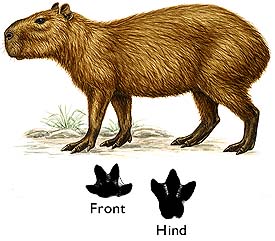 Capybara xyz
Capybara xyz
Hydrochaeris hydrochaeris
Makushi name: Paranwi
Creole name: Watras, Water Haas, Kipivara
Size: body=90 cm; weight=30 kg
Description: World’s largest rodent; unmistakable if seen well. Large stocky body; large, rectangular head; and arched, rounded rump. Fur dark reddish brown without distinctive markings. Tail not visible. Large, webbed feet. Eyeshine dull reddish.
Activity: Diurnal or nocturnal; semi-aquatic.
Habits: Social, often occurs in small family groups of 2 to 6 individuals, but larger groups are sometimes seen. Feeds mostly on grass and aquatic vegetation. It is usually seen at river’s edge or swimming. It will bark and plunge into water if alarmed and submerges completely if pursued. Calls include barks, low grunts, snorts, and twitters.
Habitat: Always found near water, it occurs in lowland forest, swamp, lagoons, gallery forest, and flooded savannah.
Signs: Huge, webbed tracks approximately 100 mm in width, with 4 toes visible in the print of the forefoot and 3 on the hindfoot. Piles of smooth, oval, greenish-brown droppings (about 50 mm in length) at water’s edge.
Status: Locally common in Iwokrama.
Distribution in Iwokrama
XYZ
